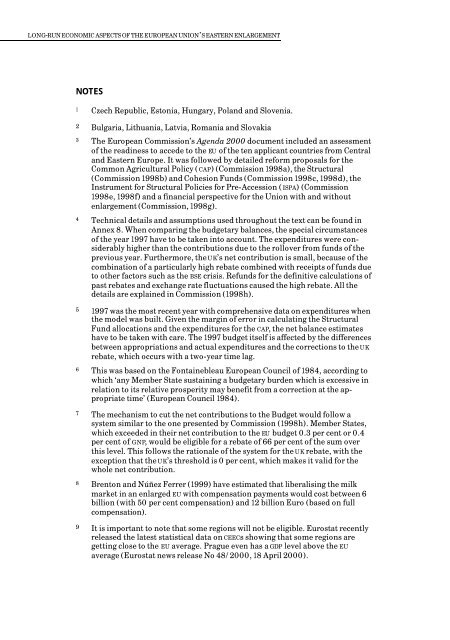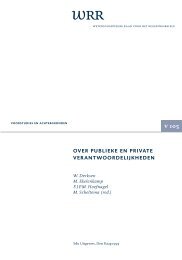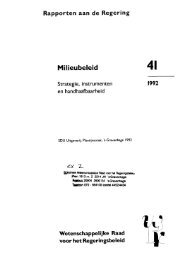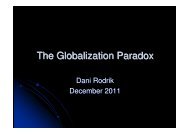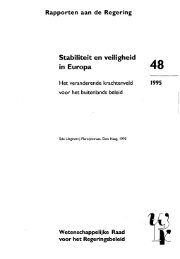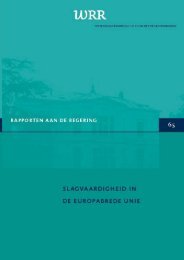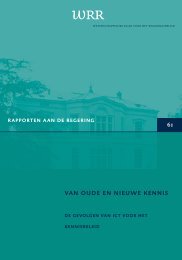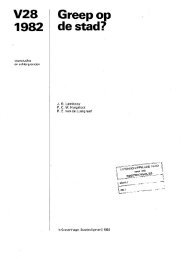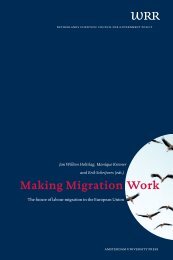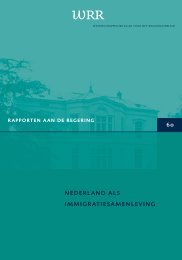w 109 long-run economic aspects of the european union's eastern ...
w 109 long-run economic aspects of the european union's eastern ...
w 109 long-run economic aspects of the european union's eastern ...
Create successful ePaper yourself
Turn your PDF publications into a flip-book with our unique Google optimized e-Paper software.
LONG-RUN ECONOMIC ASPECTS OF THE EUROPEAN UNION’S EASTERN ENLARGEMENTNOTES1 Czech Republic, Estonia, Hungary, Poland and Slovenia.2 Bulgaria, Lithuania, Latvia, Romania and Slovakia3 The European Commission’s Agenda 2000 document included an assessment<strong>of</strong> <strong>the</strong> readiness to accede to <strong>the</strong> EU <strong>of</strong> <strong>the</strong> ten applicant countries from Centraland Eastern Europe. It was followed by detailed reform proposals for <strong>the</strong>Common Agricultural Policy (CAP) (Commission 1998a), <strong>the</strong> Structural(Commission 1998b) and Cohesion Funds (Commission 1998c, 1998d), <strong>the</strong>Instrument for Structural Policies for Pre-Accession (ISPA) (Commission1998e, 1998f) and a financial perspective for <strong>the</strong> Union with and withoutenlargement (Commission, 1998g).4 Technical details and assumptions used throughout <strong>the</strong> text can be found inAnnex 8. When comparing <strong>the</strong> budgetary balances, <strong>the</strong> special circumstances<strong>of</strong> <strong>the</strong> year 1997 have to be taken into account. The expenditures were considerablyhigher than <strong>the</strong> contributions due to <strong>the</strong> rollover from funds <strong>of</strong> <strong>the</strong>previous year. Fur<strong>the</strong>rmore, <strong>the</strong> UK’s net contribution is small, because <strong>of</strong> <strong>the</strong>combination <strong>of</strong> a particularly high rebate combined with receipts <strong>of</strong> funds dueto o<strong>the</strong>r factors such as <strong>the</strong> BSE crisis. Refunds for <strong>the</strong> definitive calculations <strong>of</strong>past rebates and exchange rate fluctuations caused <strong>the</strong> high rebate. All <strong>the</strong>details are explained in Commission (1998h).5 1997 was <strong>the</strong> most recent year with comprehensive data on expenditures when<strong>the</strong> model was built. Given <strong>the</strong> margin <strong>of</strong> error in calculating <strong>the</strong> StructuralFund allocations and <strong>the</strong> expenditures for <strong>the</strong> CAP, <strong>the</strong> net balance estimateshave to be taken with care. The 1997 budget itself is affected by <strong>the</strong> differencesbetween appropriations and actual expenditures and <strong>the</strong> corrections to <strong>the</strong> UKrebate, which occurs with a two-year time lag.6 This was based on <strong>the</strong> Fontainebleau European Council <strong>of</strong> 1984, according towhich ‘any Member State sustaining a budgetary burden which is excessive inrelation to its relative prosperity may benefit from a correction at <strong>the</strong> appropriatetime’ (European Council 1984).7 The mechanism to cut <strong>the</strong> net contributions to <strong>the</strong> Budget would follow asystem similar to <strong>the</strong> one presented by Commission (1998h). Member States,which exceeded in <strong>the</strong>ir net contribution to <strong>the</strong> EU budget 0.3 per cent or 0.4per cent <strong>of</strong> GNP, would be eligible for a rebate <strong>of</strong> 66 per cent <strong>of</strong> <strong>the</strong> sum overthis level. This follows <strong>the</strong> rationale <strong>of</strong> <strong>the</strong> system for <strong>the</strong> UK rebate, with <strong>the</strong>exception that <strong>the</strong> UK’s threshold is 0 per cent, which makes it valid for <strong>the</strong>whole net contribution.8 Brenton and Núñez Ferrer (1999) have estimated that liberalising <strong>the</strong> milkmarket in an enlarged EU with compensation payments would cost between 6billion (with 50 per cent compensation) and 12 billion Euro (based on fullcompensation).9 It is important to note that some regions will not be eligible. Eurostat recentlyreleased <strong>the</strong> latest statistical data on CEECs showing that some regions aregetting close to <strong>the</strong> EU average. Prague even has a GDP level above <strong>the</strong> EUaverage (Eurostat news release No 48/2000, 18 April 2000).


